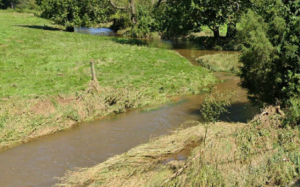Chiques Creek Watershed Legacy Sediment Project
The purpose of the Chiques Creek project is to reduce the nutrient-laden sediment loads entering the Susquehanna River and Chesapeake Bay from the Chiques Creek watershed.

The Chiques Creek Watershed lies in Pennsylvania’s most productive agricultural setting. As a result of the dominant agricultural land use, urban development, and lack of forest cover, the watershed is stressed from siltation, streamflow alterations, excess suspended sediment, and nutrient enrichment. Historic mill dams throughout the watershed have disconnected the stream channel from the historic floodplain. The primary source of sediment in Chiques Creek is streambank erosion of legacy sediment, and the total annual sediment load requires a reduction of up to 40 percent from the existing baseline to meet the targeted sediment loads.
Project Overview
Chiques Creek Watershed Legacy Sediment Project
Purpose and Objective
The purpose of the project is to reduce the nutrient-laden sediment loads entering the Susquehanna River and Chesapeake Bay from the Chiques Creek watershed.
The objective of the project is to develop land treatment concepts that focus on the stabilization or removal of legacy sediments, evaluate, and determine what treatment is best applied under certain conditions to address erosion from legacy sediment in the most cost effective and environmentally beneficial manner.
Project Approach
The project approach generally consists of the following three sequential steps:
Step 1: Identify potential project sites within the Chiques Creek watershed and Lancaster County that would provide the greatest sediment reduction opportunity. This step involves a multifactor screening process that results in the identification of prioritized project sites. First, sites will be selected based on observed erosion rate. Using mapping and data analysis tools, these sites will be prioritized based on several screening factors, which may include but are not limited to erosion rate, legacy sediment terrace volume, canopy height and density, and proximity to a historic mill dam. Finally, the sites will be selected for more detailed analysis based on several factors, which may include but are not limited to property owner interest, sediment reduction potential, floodplain management opportunities, ecological benefits, and public health and safety considerations.
Step 2: Develop land treatment project concepts that focus on the stabilization or removal of legacy sediments and develop cost analyses. The selected sites will be analyzed to identify the best potential treatment method for the legacy sediment. Site analysis will include on-site data collection such as field surveys and obtaining material samples for testing. The site data and characterization will be used to select appropriate treatment methods. Identified treatment concepts currently include scour/remove the legacy sediment and site restoration (wetlands or riparian forested corridors), stabilize the legacy sediment in place, reforest/install riparian buffers, mill dam removal (for sites with historic mill dams), or a combination of the treatments. Project concepts will be developed based on the selected treatment methods for the sites.
Step 3: Evaluate and compare the treatment type concepts for the different project sites in terms of sediment reduction potential, environmental benefit, and cost. The overall benefits and potential costs of viable projects will be the basis for a final recommendation to NRCS regarding the pursuance of funding for legacy sediment treatment in the Chiques Creek Watershed.
Project Schedule
First Public Meeting - 7/27/2022
Select representative treatment project sites - 8/1/2022 - 12/12/2022
Conduct site reconnaissance and evaluate treatment alternatives - 1/9/2023 - 1/13/2023
Second Public Meeting - July 18, 2024
Public review of final draft documents - January 2025
Project Completion -April 2025
Project Outcome
The outcome of the Chiques Creek Watershed Legacy Sediment Project will be a report that provides a conclusion on whether riparian zone sediment reduction projects are economically feasible and mutually beneficial in the Chiques Creek Watershed.
Scoping Meetings
Two scoping meetings were held on July 27, 2022. The meetings were held in person at the Rapho Township Building, Rapho Township, Lancaster County, PA as well as virtually through Zoom. The meeting provided a forum for agencies, partners, and the public to learn about the project, ask questions, and address concerns. Specifically, participants were asked to provide input on scoping resource concerns and screening metrics to determine objectives for potential legacy sediment projects. The meeting minutes from each meeting, with attached PowerPoint slides, can be accessed below. Recordings of the meetings are also posted.
A second scoping meeting was held on July 18, 2024. The meeting was held in person at the Mount Joy Township Building, Elizabethtown, PA . at 6 pm. A video of the meeting as well as the Meeting agenda with the presentation is provided below.


